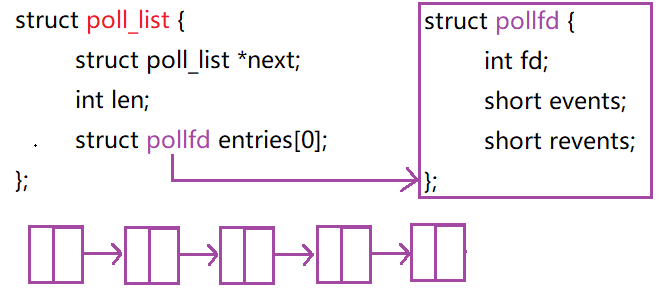poll源码剖析
Poll系统调用,是在指定时间内轮询一定数量的文件描述符,以测试是否有就绪者。
函数原型:
int poll (struct poddfd *fds, nfds_t nfds, int timeout);
· fds参数是一个pollfd结构类型的数组,指定所有感兴趣的文件描述符上发生的可读,可写和异常等事件。
· nfds参数指定被监听事件集合fds的大小。
typedef unsigned long int nfds_t;
· timeout参数指定poll的超时值,单位是毫秒。
当超时为-1时,轮询调用将一直阻塞,直到某个事件发生;当超时为0时,轮询调用立即返回。
基本数据结构
一个pollfd结构类型的数组,指定所有感兴趣的文件描述符上发生的可读,可写和异常等事件。
fd是文件描述符;事件是注册的事件,即监听FD上的事件; revents中是指实际发生的事情,由内核填充。
struct pollfd {
int fd;
short events;
short revents;
};poll_wqueues:
struct poll_wqueues {
poll_table pt;
struct poll_table_page * table;
int error;
};poll_table_entry:
struct poll_table_entry {
struct file * filp;
wait_queue_t wait;/* 等待队列*/
wait_queue_head_t * wait_address;
};poll_list:
struct poll_list {
struct poll_list *next;
int len;
struct pollfd entries[0];
};链表结点由一个指向struct poll_list的指针掌控,而众多strut pollfd就通过struct list的entries成员访问。
每个链表的节点是一个page大小(通常是4K)
基本结构关系:
Poll系统调用原理:
先注册回调函数__poll_wait,再初始化table variable(类型为struct poll_wqueues);拷贝用户传入的struct pollfd;
轮流调用所有FD对应的轮询(把current挂到每个FD对应的设备等待队列上)。在设备收到一条消息或填写完文件数据(磁盘设备)后,会唤醒设备等待队列上的进程,这时current便被唤醒了。
当前唤醒后离开sys_poll。
(主要基于内核源代码2.6.9版本,在FD \ select.c中)
sys_poll
asmlinkage long sys_poll(struct pollfd __user * ufds, unsigned int nfds, long timeout)
{
struct poll_wqueues table;
int fdcount, err;
unsigned int i;
struct poll_list *head;
struct poll_list *walk;
/* Do a sanity check on nfds ... OPEN_MAX=256*/
if (nfds > current->files->max_fdset && nfds > OPEN_MAX)
return -EINVAL;
if (timeout) {
/* Careful about overflow in the intermediate values */
if ((unsigned long) timeout < MAX_SCHEDULE_TIMEOUT / HZ)
timeout = (unsigned long)(timeout*HZ+999)/1000+1;
else /* Negative or overflow */
timeout = MAX_SCHEDULE_TIMEOUT;
}
poll_initwait(&table);
head = NULL;
walk = NULL;
i = nfds;
err = -ENOMEM;
while(i!=0) {
struct poll_list *pp;
pp = kmalloc(sizeof(struct poll_list)+
sizeof(struct pollfd)*
(i>POLLFD_PER_PAGE?POLLFD_PER_PAGE:i),
GFP_KERNEL);
if(pp==NULL)
goto out_fds;
pp->next=NULL;
pp->len = (i>POLLFD_PER_PAGE?POLLFD_PER_PAGE:i);
if (head == NULL)
head = pp;
else
walk->next = pp;
walk = pp;
if (copy_from_user(pp->entries, ufds + nfds-i,
sizeof(struct pollfd)*pp->len)) {
err = -EFAULT;
goto out_fds;
}
i -= pp->len;
}
fdcount = do_poll(nfds, head, &table, timeout);
/* OK, now copy the revents fields back to user space. */
walk = head;
err = -EFAULT;
while(walk != NULL) {
struct pollfd *fds = walk->entries;
int j;
for (j=0; j < walk->len; j++, ufds++) {
if(__put_user(fds[j].revents, &ufds->revents))
goto out_fds;
}
walk = walk->next;
}
err = fdcount;
if (!fdcount && signal_pending(current))
err = -EINTR;
out_fds:
walk = head;
while(walk!=NULL) {
struct poll_list *pp = walk->next;
kfree(walk);
walk = pp;
}
poll_freewait(&table);
return err;
}
(1)poll_initwait()
void poll_initwait(struct poll_wqueues *pwq)
{
init_poll_funcptr(&pwq->pt, __pollwait);
pwq->error = 0;
pwq->table = NULL;
}static inline void init_poll_funcptr(poll_table *pt, poll_queue_proc qproc)
{
pt->qproc = qproc;
}注册回调函数__pollwait,
void __pollwait(struct file *filp, wait_queue_head_t *wait_address, poll_table *_p)
{
struct poll_wqueues *p = container_of(_p, struct poll_wqueues, pt);
struct poll_table_page *table = p->table;
if (!table || POLL_TABLE_FULL(table)) {
struct poll_table_page *new_table;
new_table = (struct poll_table_page *) __get_free_page(GFP_KERNEL);
if (!new_table) {
p->error = -ENOMEM;
__set_current_state(TASK_RUNNING);
return;
}
new_table->entry = new_table->entries;
new_table->next = table;
p->table = new_table;
table = new_table;
}
/* Add a new entry */
struct poll_table_entry * entry = table->entry;
table->entry = entry+1;
get_file(filp);
entry->filp = filp;
entry->wait_address = wait_address;
init_waitqueue_entry(&entry->wait, current);
add_wait_queue(wait_address, &entry->wait);
}
(2)调用copy_from_user()
这里的循环中,建立链表,然后调用copy_from_user将文件描述符从用户空间拷贝到内核空间。也就是把用户态的struct pollfd拷进进这些条目中。通常用户程序的poll调用就监控几个fd,所以上面这个链表通常也就只需要一个节点,即操作系统的一页。
但是,当用户传入的fd很多时,由于poll系统调用每次要把所有的struct pollfd拷进进内核,所以参数传递和页分配此时就成了poll系统调用的性能瓶颈。
/**
* 从用户空间复制任意大小的块。
*/
unsigned long
copy_from_user(void *to, const void __user *from, unsigned long n)
{
might_sleep();
BUG_ON((long) n < 0);
if (access_ok(VERIFY_READ, from, n))
n = __copy_from_user(to, from, n);
else
memset(to, 0, n);
return n;
}(3)do_poll()
static int do_poll(unsigned int nfds, struct poll_list *list,
struct poll_wqueues *wait, long timeout)
{
int count = 0;
poll_table* pt = &wait->pt;
if (!timeout)
pt = NULL;
for (;;) {
struct poll_list *walk;
set_current_state(TASK_INTERRUPTIBLE);
walk = list;
while(walk != NULL) {
do_pollfd( walk->len, walk->entries, &pt, &count);
walk = walk->next;
}
pt = NULL;
if (count || !timeout || signal_pending(current))
break;
count = wait->error;
if (count)
break;
timeout = schedule_timeout(timeout);
}
__set_current_state(TASK_RUNNING);
return count;
}
在对循环中,直到计数大于0才跳出循环。而count 主要是依靠do_pollfd函数处理。
而当用户传入的FD很多时(比如1000个),对do_pollfd就会调用很多次,调查效率出现瓶颈。
set_current _STATE和signal_pending函数
保障了当用户程序在调用调查后挂起时,发信号可以让程序迅速退出民调调用,而通常的系统调用是不会被信号打断的。
do_pollfd()
static void do_pollfd(unsigned int num, struct pollfd * fdpage,
poll_table ** pwait, int *count)
{
int i;
for (i = 0; i < num; i++) {
int fd;
unsigned int mask;
struct pollfd *fdp;
mask = 0;
fdp = fdpage+i;
fd = fdp->fd;
if (fd >= 0) {
struct file * file = fget(fd);
mask = POLLNVAL;
if (file != NULL) {
mask = DEFAULT_POLLMASK;
if (file->f_op && file->f_op->poll)
mask = file->f_op->poll(file, *pwait);
mask &= fdp->events | POLLERR | POLLHUP;
fput(file);
}
if (mask) {
*pwait = NULL;
(*count)++;
}
}
fdp->revents = mask;
}
}
如果FD对应的是某个 socket,do_pollfd调用的就是网络设备驱动实现的轮询;
如果FD对应的是某个EXT3文件系统的一个打开文件,那么do_pollfd调用的就是EXT3文件系统驱动实现的Poll。
这个file- > f_op->poll的是设备驱动程序实现的。
而设备驱动程序的标准实现是:
(1)调用poll_wait,即以设备自己的等待队列为参数(通常设备都有自己的等待队列)
(2)调用struct poll_talbe的回调函数。
__pollwait
回调函数__pollwait的作用是创建一个poll_table_entry数据结构(一次__poll_wait即一次设备poll调用只创建一个poll_table_entry),并通过struct poll_table_entry的wait成员,把currrent挂在设备的等待队列上,此处的等待队列是wait_address,对应tcp_poll中的SK-Ⅱ> sk_sleep。
void __pollwait(struct file *filp, wait_queue_head_t *wait_address, poll_table *_p)
{
struct poll_wqueues *p = container_of(_p, struct poll_wqueues, pt);
struct poll_table_page *table = p->table;
if (!table || POLL_TABLE_FULL(table)) {
struct poll_table_page *new_table;
new_table = (struct poll_table_page *) __get_free_page(GFP_KERNEL);
if (!new_table) {
p->error = -ENOMEM;
__set_current_state(TASK_RUNNING);
return;
}
new_table->entry = new_table->entries;
new_table->next = table;
p->table = new_table;
table = new_table;
}
/* Add a new entry */
struct poll_table_entry * entry = table->entry;
table->entry = entry+1;
get_file(filp);
entry->filp = filp;
entry->wait_address = wait_address;
init_waitqueue_entry(&entry->wait, current);
add_wait_queue(wait_address, &entry->wait);
}接着调用tcp_poll(),
unsigned int tcp_poll(struct file *file, struct socket *sock, poll_talbe *wait)
{
unsigned int mask;
struct sock *sk = sock->sk;
struct tcp_sock *tp = tcp_sk(sk);
poll_wait(file, sk->sk_sleep, wait);
......//省略判断状态,返回状态值
}
struct sock是socket连接的内核表示,sk->sk_sleep是struct wait_queue_head_t结构类型,这表示的是socket的等待队列,每一个socket都有自己的一个等待队列,由内核结构struct sock来维护。
其实大多数驱动实现的时候,此时都调用这个函数poll_wait.
poll_wait(file, sk->sk_slepp, wait);
间接调用p->qproc(file, sk->sk_slepp, wait);
总结:
1. 统一处理所有事件类型,只需一个事件集参数。用户通过pollfd.events传入感兴趣事件,内核通过修改pollfd.revents成员反馈其中就绪的事件,而events成员保持不变,下此调用poll时无须重置pollfd类型的事件集参数。
2. poll和select类似,每次调用都返回整个用户注册的事件集合(包括就绪的和未就绪的),应用程序索引就绪文件描述符的时间复杂度为O(n)。而epoll是在内核中维护一个事件表,epoll_wait的events参数返回就绪的事件,时间复杂度为O(1).
3. poll和epoll_wait分别用nfds和maxevents参数指定最多监听多少个文件描述符和事件个数,即65535(cat/proc/sys/fs/file-max)。而select允许监听的最大文件描述符个数为1024.
4. poll只能工作在相对低效的LT模式(电平触发),而epoll可工作在ET高效模式(边沿触发)。
5. poll采用轮询方式,即每次调用都要扫描整个注册文件描述符集合,并将其中就绪的文件描述符返回个用户,因此检测就绪事件的时间复杂度是O(n)。epoll则采用回调方式。内核检测到就绪的文件描述符,将触发回调函数,回调函数将该文件描述符上对应的事件插入内核就绪事件队列。内核最后将该就绪事件队列的内容拷贝到用户空间。时间复杂度为O(1).
缺点
1. 在sys_poll中的循环中,建立链表,然后调用copy_from_user将文件描述符从用户空间拷贝到内核空间。也就是把用户态的struct pollfd拷进进这些条目中。通常用户程序的poll调用就监控几个fd,所以上面这个链表通常也就只需要一个节点,即操作系统的一页。
但是,当用户传入的fd很多时,由于poll系统调用每次要把所有的struct pollfd拷进进内核,所以参数传递和页分配此时就成了poll系统调用的性能瓶颈。
2. 在函数do_poll()中的循环语句中,直到计数大于0才跳出循环。而count 主要是依靠do_pollfd函数处理。
而当用户传入的FD很多时(比如1000个),对do_pollfd就会调用很多次,调查效率出现瓶颈。
应用场景
1. 适用于I/O少,即连接数量少,但活动连接多的情况。socket少于1000个。
2. 没有其他线程干扰。

